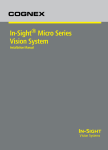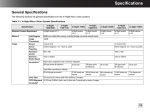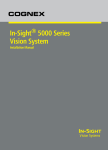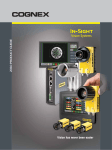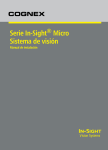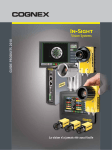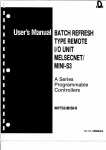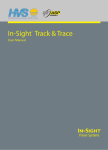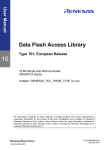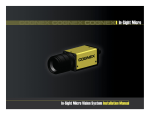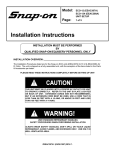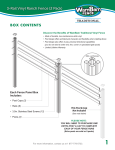Download In-Sight® Micro Series Vision System Installation Manual Addendum
Transcript
Addendum Sheet In-Sight® Micro Series Vision System Installation Manual The In-Sight® Micro series of vision systems now includes the In-Sight 1402. This addendum includes hardware specifications to support this vision system, along with updates and corrections to existing precautions and regulations/conformity information. This information will be included in the next revision of the In-Sight® Micro Series Vision System Installation Manual. Please keep this addendum with your installation manual. 1 Regulations/Conformity Note: For the most up-to-date regulations and conformity information, please refer to the In-Sight online support site: http://www.cognex.com/Support/InSight. Declaration of Conformity Manufacturer Cognex Corporation One Vision Drive Natick, MA 01760 USA Declares this -marked Machine Vision System Product Product Type In-Sight Micro 1020/1050/1100/1110/1400/1410: Type 821-0043-1R In-Sight Micro 1100C/1400C: Type 821-0044-1R In-Sight Micro 1402: Type 821-0078-1R In-Sight Micro 1403/1413: Type 821-0047-1R In-Sight Micro 1403C: Type 821-0048-1R Complies With 2004/108/EC Electromagnetic Compatibility Directive Compliance Standards EN 55022:2006 + A1:2007 Class A EN 61000-6-2:2005 European Representative COGNEX INTERNATIONAL Immeuble “Le Patio” 104 Avenue Albert 1er 92563 Rueil Malmaison Cedex - France FCC FCC Part 15, Class A This device complies with Part 15 of the FCC Rules. Operation is subject to the following two conditions: (1) this device may not cause harmful interference; and (2) this device must accept any interference received, including interference that may cause undesired operation. This equipment generates, uses, and can radiate radio frequency energy and, if not installed and used in accordance with the instruction manual, may cause harmful interference to radio communications. Operation of this equipment in a residential area is likely to cause harmful interference in which case the user will be required to correct the interference at their own expense. KCC In-Sight Micro 1020/1050/1100/1110/1400/1410: CGX-ISM1400-00(A) In-Sight Micro 1100C/1400C: CGX-ISM1400-C00(A) In-Sight Micro 1402: KCC-REM-CGX-ISM1402-01 In-Sight Micro 1403/1413: CGX-ISM1403-00(A) In-Sight Micro 1403C: CGX-ISM1403-C00(A) NRTL TÜV SÜD AM SCC/NRTL OSHA Scheme for UL/CAN 60950-1. CB TÜV SÜD AM, IEC/EN 60950-1. CB report available upon request. RoHS RoHS 6 Compliant. Safety and Regulatory 2 Precautions Observe these precautions when installing the vision system to reduce the risk of injury or equipment damage: l An IEEE 802.3af compliant, and UL or NRTL listed, Power over Ethernet (PoE) power source rated Class 0, 2, 3 or 4 must be used. Any other voltage creates a risk of fire or shock and can damage the In-Sight vision system components. Applicable local and national wiring standards and rules must be followed. l To reduce the risk of damage or malfunction due to over-voltage, line noise, electrostatic discharge (ESD), power surges, or other irregularities in the power supply, route all cables and wires away from high-voltage power sources. l Do not install In-Sight vision systems where they are directly exposed to environmental hazards such as excessive heat, dust, moisture, humidity, impact, vibration, corrosive substances, flammable substances, or static electricity. l Do not expose the image sensor to laser light; image sensors can be damaged by direct, or reflected, laser light. If your application requires the use of laser light that may strike the image sensor, a lens filter at the corresponding laser's wavelength is recommended. Contact your local integrator or application engineer for suggestions. l The In-Sight vision system does not contain user-serviceable parts. Do not make electrical or mechanical modifications to In-Sight vision system components. Unauthorized modifications may void your warranty. l Changes or modifications not expressly approved by the party responsible for regulatory compliance could void the user’s authority to operate the equipment. l Service loops should be included with all cable connections. l Cable shielding can be degraded or cables can be damaged or wear out more quickly if a bend radius or service loop is tighter than 10X the cable diameter. l Class A Equipment (broadcasting and communication equipment for office work): Seller and user shall be notified that this equipment is suitable for electromagnetic equipment for office work (Class A) and can be used outside the home. l This device should be used in accordance with the instructions in this manual. 3 Specifications The following sections list general specifications for the In-Sight Micro vision systems. In-Sight Micro Vision System Specifications Table 4-1: In-Sight Micro Vision System Specifications Specifications 1020/1050 1100/1110 1100C 1400/1410 1400C 1402 In-Sight version 4.6.0 1403/1413 1403C Minimum Firmware Requirement In-Sight version 4.4.3 In-Sight version 4.4.3 Job/Program Memory 128MB non-volatile flash memory; unlimited storage via remote network device. Image Processing Memory 256MB Sensor Type 1/3-inch CCD 1/1.8-inch 1/1.8-inch CCD CMOS Sensor Properties 5.92mm diagonal, 7.4 x 7.4µm sq. pixels 8.7mm 8.8mm diagonal, 4.4 x diagonal, 4.4µm sq. pixels 5.3 x 5.3µm sq. pixels Resolution (pixels) 640 x 480 1280 x 1024 Electronic Shutter Speed 16µs to 1000ms Acquisition Rapid reset, progressive scan, full-frame integration. Bit Depth 256 grey levels (8 bits/pixel) Image Gain/Offset Controlled by software. Frames Per Second1 60 full frames per second 58 full frames per second Lens Type CS-mount and C-mount (with 5mm extension, included). Image Sensor Alignment Variability2 ±0.127mm (0.005in), (both x and y) from lens C-mount axis to center of imager. Trigger 1 opto-isolated, acquisition trigger input. Remote software commands via Ethernet. (RS-232C available when using the optional CIO-MICRO or CIO-MICRO-CC I/O module.) Discrete Inputs None. (Eight additional inputs available when using the optional CIO-MICRO or CIO-MICRO-CC I/O module.) Discrete Outputs 2 opto-isolated, NPN/PNP high-speed outputs. (Eight additional outputs available when using the optional CIO-MICRO or CIO-MICRO-CC I/O module.) Status LEDs Network, 2 user-configurable. 1600 x 1200 52µs to 1000ms 24 bit color 256 grey levels (8 bits/pixel) 24 bit color 256 grey levels (8 bits/pixel) 24 bit color 60 full frames per second 58 full frames per second 60 full 14 full frames per frames per second second 7 full frames per second 1 Maximum frames per second is job-dependent and based on the minimum exposure for a full image frame capture. 2 Expected variability in the physical position of the image sensor, from vision system-to-vision system. This equates to ~ ±17 pixels on a 640 x 480 resolution CCD, ~ ±24 pixels on a 1280 x 1024 resolution CMOS and ~ ±29 pixels on a 1600 x 1200 resolution CCD. 4 Specifications 1020/1050 1100/1110 1100C 1400/1410 1400C 1402 1403/1413 1403C Network 1 Ethernet port, 10/100 BaseT with auto MDI/MDIX. Supports DHCP (factory default), static and linkCommunication local IP address configuration. Serial None. (RS-232C: 4800 to 115,200 baud rates when connected to the optional CIO-MICRO or CIOCommunication MICRO-CC I/O module). Power Class 2 Power over Ethernet (PoE) device. Power Type A and B. Power Consumption 6.49 W maximum per Class 2 PoE. Current Per Class 2 PoE requirements. Voltage 48 V nominal, applied from a Class 2 PoE injector which is typically powered from some other voltage. Material Die-cast zinc housing. Finish Painted Mounting Four M3 threaded mounting holes (1/4 - 20 and M6 mounting holes also available on mounting block). Dimensions 30mm (1.18in) x 30mm (1.18in) x 60mm (2.36in) without mounting block. 30mm (1.18in) x 38.2mm (1.50in) x 60mm (2.36in) with mounting block. Weight 121g (4.27oz.) without mounting block. 146g (5.15oz.) with mounting block. Temperature Operating: 0°C to 45°C (32°F to 113°F) Storage: -30°C to 80°C (-22°F to 176°F) Humidity 90%, non-condensing (Operating and Storage) Protection IP51 with cables and lens attached. Shock 80 G shock with 50 gram or lighter lens attached per IEC 68-2-27 EA. Vibration 10 G with 50 gram or lighter lens attached 2 hrs/axis (10-500 Hz) per IEC 68-2-6, FC. Regulatory Compliance CE, FCC, KCC, TÜV SÜD NRTL, RoHS 5 Acquisition Trigger Input Table 4-2: Acquisition Trigger Input Specifications Specification Voltage Current Delay1 Description ON OFF ON OFF Resistance In-Sight Micro 1020, 1050, 1100, 1100C, 1110, 1400, 1400C, 1402 & 1410 In-Sight Micro 1403 & 1413 In-Sight Micro 1403C 20 to 28V (24V nominal) 0 to 3V (8V nominal threshold) 2.0 to 2.9mA < 250µA ~10,000 Ohms 63µs maximum latency between leading edge of trigger and start of acquisition. Input pulse should be minimum of 1 ms wide. 81µs maximum latency between leading edge of trigger and start of acquisition. Input pulse should be minimum of 1 ms wide. 116µs maximum latency between leading edge of trigger and start of acquisition. Input pulse should be minimum of 1 ms wide. The acquisition trigger input is opto-isolated. To trigger from an NPN (pull-down) type photoelectric sensor or PLC output, connect pin 3 (TRG+) to +24V and connect pin 4 (TRG-) to the output of the photoelectric sensor. When the output turns ON, it pulls TRG- down to 0V, turning the opto-coupler ON. To trigger from a PNP (pull-up) photoelectric sensor or PLC output, connect pin 3 (TRG+) to the output of the photoelectric sensor and connect pin 4 (TRG-) to 0V. When the output turns ON, it pulls TRG+ up to 24V, turning the opto-coupler ON. Figure 4-1: Acquisition Trigger Input Schematic P/N 597-0136-01 Printed in the USA 1 Maximum latency is based on a 1µs trigger debounce. 6






